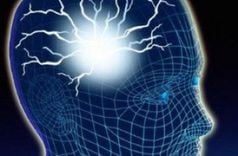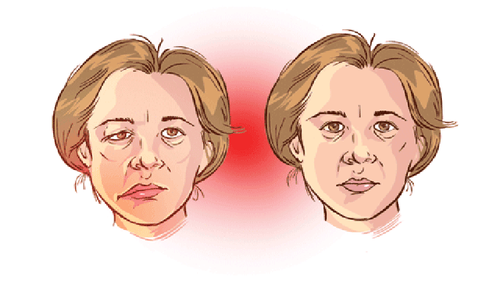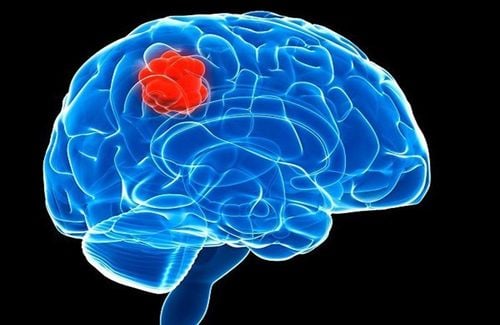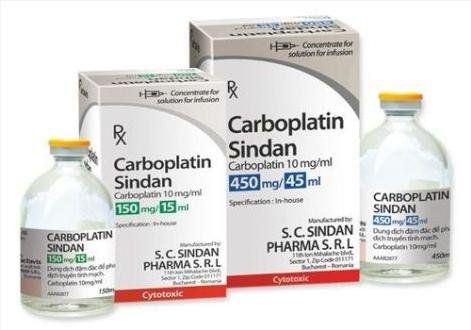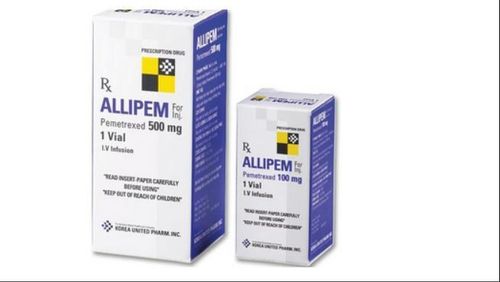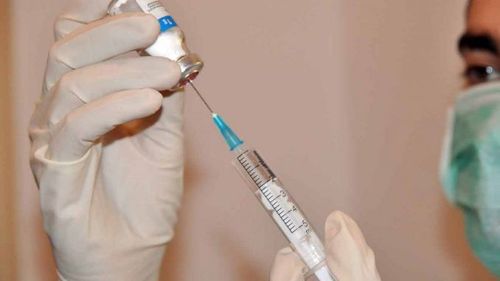Bài viết bởi Bác sĩ Phạm Anh Tuấn - Viện nghiên cứu Tế bào gốc và Công nghệ gen Vinmec
Trong số những người mắc loại ung thư phổi phổ biến nhất, có tới 40% bệnh nhân tiến triển khối u não di căn, với thời gian sống trung bình dưới sáu tháng. Nhưng tại sao ung thư phổi không tế bào nhỏ (NSCLC) thường di căn đến não vẫn còn là điều chưa được hiểu rõ.
Gần đây, các nhà khoa học tại Trường Y khoa Wake Forest đã phát hiện ra rằng nicotine, một chất không gây ung thư có trong thuốc lá, thực sự thúc đẩy sự lây lan/di căn của các tế bào ung thư phổi vào não.
Giáo sư Kounosuke Watabe, trưởng nhóm nghiên cứu, tại trường Y khoa Wake Forest cho biết: "Dựa trên những phát hiện của chúng tôi, chúng tôi không nghĩ rằng các sản phẩm thay thế nicotine là cách an toàn nhất để những người mắc bệnh ung thư phổi cai thuốc lá".
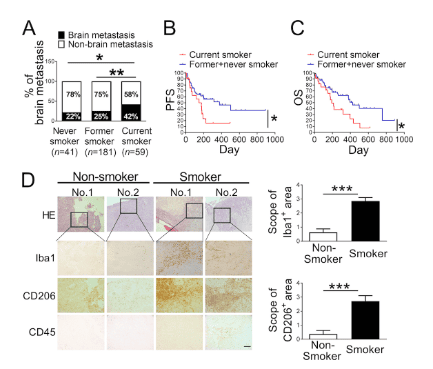
(A) Incidence of brain metastasis among 281 stage IV lung cancer patients composed of both current and noncurrent smokers at the time of diagnosis. All patients were admitted to Wake Forest Baptist Hospital. (B and C) Progression-free survival (PFS; B) and overall survival (OS; C) of patients with brain metastasis (n = 79) and with or without smoking history were examined by Kaplan–Meier analysis. (D) Representative images of immunohistochemical analysis for Iba1+, CD206+, and CD45+ cells in the H&E-stained brain metastatic lesions of lung cancer patients who were current smokers (n = 7) and noncurrent smokers (n = 4). Scale bar, 100 μm. *, P < 0.05; **, P < 0.01; and ***, P < 0.001.
Trong nghiên cứu, được công bố trên Tạp chí Y học Thực nghiệm ngày 4 tháng 6, nhóm nghiên cứu của Giáo sư Watabe lần đầu tiên kiểm tra 281 bệnh nhân ung thư phổi và phát hiện ra rằng những người hút thuốc lá có tỷ lệ mắc ung thư não cao hơn đáng kể.
Sau đó, sử dụng mô hình chuột, các nhà nghiên cứu đã phát hiện ra rằng nicotine tăng cường sự di căn não bằng cách vượt qua hàng rào máu não (Blood Brain Barrier-BBB) để làm thay đổi chức năng của microglia - một loại tế bào miễn dịch trong não - từ bảo vệ sang thúc đẩy phát triển khối u.
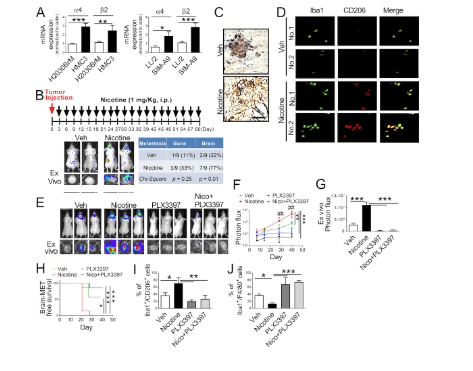
(A) Expression of α4β2 nicotine receptor on human microglia (HMC3), mouse microglia (SIM-A9), human lung cancer cells (H2030BrM), and mouse lung cancer cells (LL/2) were evaluated by qRT-PCR (n = 3/group). (B) LL/2 (5×104 cells) were intracardially injected into immune-competent BALB/c mice (n = 9). After 3 d of intracardiac transplantation of LL/2 cells, mice received nicotine treatment (1 mg/kg) by intraperitoneal injection every 3 d for 60 d. Upper panel: BLI images of brain metastatic lesions of representative mice from each experimental group (vehicle alone or nicotine treatment). Lower panel: total photon flux of ex vivo image of brain metastatic lesions was measured by BLI at the end point (day 60). Quantitative data of bone and brain metastasis of lung cancer are shown in the right panel. (C) At the end point, the brain sections from mice with or without treatment with nicotine were examined for Iba1+ signal (brown) on microglia. Scale bar, 20 μm. (D) Representative images of immunohistochemical analysis for CD206+ and Iba1+ microglia in the metastatic brain lesions of mice that were treated with or without nicotine (n = 9/group). Scale bar, 100 μm. (E) Mouse lung cancer LL/2 cells were intracranially injected into wild-type BALB/c mice (n = 9/group) followed by administering PLX3397 by intracranial injection. Upper panels are BLI images of brain metastatic lesions of representative mice from each experimental group at day 40. Lower panels represent the total photon flux of ex vivo brain metastatic lesions as measured by BLI at the end point (day 40). (F) Quantitative data of in vivo brain metastasis of lung cancer (n = 9/group). (G) Ex vivo BLI signals in the brain at the end point (n = 9/group). (H) Kaplan–Meier analysis of brain metastasis–free survival was performed (n = 9/group). (I and J) Metastatic brain tumors in E were isolated from the brain and were examined by FACS for M2 (I) and M1 (J) microglial polarization (n = 4 or 5/group). The data are presented as the mean ± SD. *, P < 0.05; **, P < 0.01; and ***, P < 0.001 versus respective nicotine group. ##, P < 0.01 versus respective PLX3397 or Nico+PLX3397 group.
Cúc thơm (feverfew) là một loại thảo dược thân ngắn, dạng bụi cao từ 0.3m đến 1m thuộc họ Cúc (Asteraceae), có tên khoa học là Tanacetum Parthenium L. Watabe và các đồng nghiệp đã tìm kiếm các loại thuốc có thể đảo ngược tác dụng của nicotine và đã xác định parthenolide, một chất tự nhiên trong thuốc hạ sốt thảo dược này, có thể ngăn chặn sự di căn khối u lên não do nicotine ở chuột. Do cúc thơm đã được sử dụng trong nhiều năm và được coi là an toàn, do đó Watabe tin rằng parthenolide có thể cung cấp một phương pháp mới để chống lại sự di căn não, đặc biệt đối với những bệnh nhân đã từng hút thuốc hoặc vẫn đang hút thuốc.
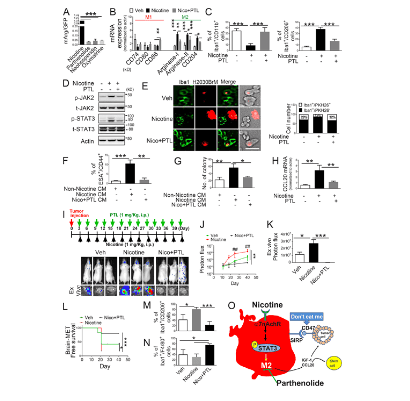
(A) Human microglia cells (HMC3) with the Arg1 reporter plasmid were cultured in the presence or absence of compounds that were identified as the top three most effective inhibitors for Arg1 during our initial screening (see Materials and methods). After 48 h of incubation, luciferase reporter activity was measured (n = 4/group). (B) Expression of surface markers of M1/M2 microglia was examined by qRT-PCR after microglial cells were treated with or without nicotine plus PTL (n = 4/group). (C) The same set of samples in B was evaluated for quantification of Iba1+/CD11b+ (M1) cells and Iba1+/CD206+ (M2) cells by FACS (n = 4/group). (D) The same set of samples in C was examined for quantification of the protein expression of JAK2 and STAT3 by Western blot. (E) Human microglial (HMC3) cells (green) with or without nicotine treatment (1 μM) in the presence or absence of PTL (1 μM) were incubated with PKH26-labeled H2030BrM cells (red) for 24 h and photographed (left panels), followed by measurement of the microglial phagocytic activity (right panel; n = 4/group). Scale bar, 10 μm. (F) CM was prepared from human microglia (HMC3) treated with or without nicotine and PTL. The CM was added to the culture of H2030BrM, and cells were incubated for 48 h followed by evaluation of CSC population by FACS. Non-nicotine, nicotine, or Nico+PTL CM: microglia were treated with PBS, nicotine, or nicotine plus PTL for 24 h. They were then washed twice with PBS and incubated in the fresh DMEM/F12 medium supplemented with 2% FBS for a further 24 h (n = 4/group). (G) For the same set of samples as F, colony-forming ability was also measured (n = 4/group). (H) Human microglia were treated with or without nicotine (1 μM) in the presence or absence of PTL for 24 h, followed by assessment of the expression of CCL20 by qRT-PCR (n = 4/group). (I) The mouse lung cancer cells, LL/2, were intracardially injected into wild-type BALB/c mice. After 3 d of intracranial transplantation of LL/2 cells, mice received nicotine (1 mg/kg) plus PTL (1 mg/kg) by an intraperitoneal injection every 3 d for 40 d. Upper panel: BLI images of representative mice from each experimental group at day 40. Lower panel: total photon flux of ex vivo brain metastatic lesions was measured by BLI at the endpoint (day 40; n = 9/group). (J) Quantitative data of BLI in the brain regions are shown (n = 9/group). (K) Ex vivo signals in the whole brains at the end point were quantified. (L) The Kaplan–Meier analysis of brain metastasis–free survival was performed (n = 9/group). (M and N) Metastatic brain tumors in I were isolated from the brain and were examined by FACS for M2 (M) and M1 (N) microglial polarization (n = 9/group). (O) A proposed model illustrating a nicotine-induced brain metastasis (n = 9/group). The data are presented as the mean ± SD. *, P < 0.05; **, P < 0.01; and ***, P < 0.001.
Hiện tại, phương pháp điều trị duy nhất ung thư phổi, căn bệnh tàn khốc này là xạ trị. Các loại thuốc hóa trị truyền thống lại không thể vượt qua hàng rào máu não, tuy nhiên parthenolide lại có khả năng. Do đó, hứa hẹn đây là một phương pháp điều trị hoặc thậm chí có thể là cách để ngăn chặn sự di căn khối u lên não.
Nhóm nghiên cứu cho biết sẽ hợp tác với các bác sĩ ung thư tại Trường Y khoa Wake Forest, để phát triển một thử nghiệm lâm sàng nhằm thử nghiệm parthenolide trong tương lai gần.
Để đặt lịch khám tại viện, Quý khách vui lòng bấm số HOTLINE hoặc đặt lịch trực tiếp TẠI ĐÂY. Tải và đặt lịch khám tự động trên ứng dụng MyVinmec để quản lý, theo dõi lịch và đặt hẹn mọi lúc mọi nơi ngay trên ứng dụng.
Tài liệu tham khảo:
- Kounosuke Watabe, Andrew Dothard, Thomas W. Lycan, Jimmy Ruiz, Michael Chan, Wei Zhang, Tamjeed Ahmed, Yusuke Shiozawa, Ravindra Pramod Deshpande, Dan Zhao, Yin Liu, Abhishek Tyagi, Kerui Wu, Sambad Sharma, Fei Xing, Shih-Ying Wu. Nicotine promotes brain metastasis by polarizing microglia and suppressing innate immune function. Journal of Experimental Medicine, 2020; 217 (8)
- Kakusa, B., S. Han, S. Aggarwal, B. Liu, G. Li, S. Soltys, and M. Hayden Gephart. 2018. Clinical factors associated with mortality within three months after radiosurgery of asymptomatic brain metastases from non-small cell lung cancer. J. Neurooncol. 140:705–715.
- Fidler, I.J.. 2015. The Biology of Brain Metastasis: Challenges for Therapy. Cancer J. 21:284–293
- Bacha, S., H. Cherif, D. Rabaa, S. Habibech, S. Cheikhrouhou, H. Racil, N. Chaouch, M.L. Megdiche, and A. Chabbou. 2018. Brain metastases of non-small cell lung cancer: prognostic factors and management. Tunis. Med. 96:165–171.Cứu sống người bệnh ung thư phổi bằng thuốc đích thế hệ mới
